Abstract
Today service organizations are undergoing massive reengineering “tactics” as they are faced with increased competition, outdated technology, and a changing customer base. Service companies strive to differentiate at the quality of service they offer to their customers seeking lasting profitable customer relationships. Company leaders are beginning to embrace Customer Relationship Management (CRM) as a way to meet their business objectives, thus operating at lower cost, increasing their profitability and customer portfolio and hence their market share.
This dissertation investigates how CRM can assist service companies to meet their business objectives. In doing so companies first must ensure that they are ready to foster and support a CRM programme and also need to know who their customers are, what their needs are and how their customers value the service they get.
Within the scope of this research process the following research questions were appropriately investigated:
- Which internal fundamental factors of service companies need to be in place prior implementing a CRM strategy in order to meet their business objectives?
- Whether customer needs can be satisfied through a CRM strategy implemented by service companies?
Based on the research questions above the following hypothesis was formulated;
“Service companies implementing customer relationship management principles can value and satisfy their customers’ needs”
The research was performed based on CRM contexts as these were examined and critically analyzed by the subject matter’s literature review. The following CRM areas were examined in detail:
- Development, Definition and Role of CRM.
- CRM Technology and its Role.
- Business strategy and Customer Centric Strategies.
- CRM Metrics and Business Key Performance Indices(KPIs).
- Perils of CRM Strategies.
To facilitate this research, the insurance service company of XYZWTTT ABCDRRRRRR was used as the practical vehicle. The methodology used and the derived conclusions/recommendations are applicable to any service company.
The hypothesis set is tested through two different questionnaires addressed to XYZWManagement and XYZWcustomers, respectively. XYZWManagers were individually addressed by a self-completion questionnaire while customers were interviewed through telephone calls following a structured schedule of questions.
The findings of the two questionnaires were critically discussed with reference to appropriate theories of the literature review and suitably analysed and cross linked in order to reach the best possible conclusions and recommendations.
The findings revealed that the company is practicing CRM well without any technological support. In fact, the managers are themselves not very clear on the strategies and policies of the organization. It is imperative that they learn about the organizational policies and align their CRM strategies accordingly. The customers, nonetheless, seem to be very satisfied with the CRM of the insurance company.
Introduction
Choosing the Subject Topic
This dissertation investigates how the exploitation of a Customer Relationship Management (CRM) can assist a service company to meet its business objectives in the competitive environment in which it operates. The investigation has a wide focus approach on the CRM subject where XYZWcompany (Appendix-1.1) is used as a research vehicle towards deriving conclusions yielding to appropriate recommendations which are of wider importance and significance for any service company.
Taking into consideration the dynamic changes in the service industry and the effort of service companies to operate at higher economies of scale towards larger profit margins, Management has been seeking ways to:
- Identify the most valuable customers and segments.
- Understand customers’ wants and needs.
- Develop Company-Customer relationship over time.
- Identify market trends and new selling opportunities.
- Enhance and re-price products and services.
- Deliver the entire customer experience.
The CRM topic has been also of high interest to the academic world. There is a rich academic bibliography, white papers and Journals that on the one hand investigate the directly related topics to CRM such as Relationship Marketing, Customer Experience, Marketing Strategy, Segmentation, Customer Value and Profitability Analysis, Analysis of Market Trends, Intelligent Decision Support Systems, Datamining algorithms and other, and on the other hand investigate the many different and indirectly related vital aspects of the CRM topic, such as Managing Business Strategies, Change Management, Cultural aspects, HR aspects, Technology, and other.
It is pointed out that discussion of the concept of “Relationship Marketing” in the academic and professional press, has been of the more prominent parts of a larger scale re-evaluation of the role and direction of marketing development.
XYZWManagement has accepted the request made by the author to use XYZWas the practical vehicle to investigate how the implementation of a CRM business strategy could help service companies to meet their business objectives.
Importance of CRM to Business
Excellent customer service starts by first taking the time to get to know the customers, their preferences, vision, frustrations and goals. Once there is a good understanding of what is on customers’ heart and mind, then companies may offer to customers long lasting relationships, innovative products/services at competitive prices enhancing their value and loyalty toward higher retention and acquisition and hence increase of market share.
CRM provides for the above enabling organizations to establish more profitable customer relationships
- operating at lower cost,
- establishing and maintaining a direct relationship with customers,
- integrating company’s sales, marketing and service operations,
- providing comprehensive and up to date information about market trends, customers, their needs, and company’s performance, and
- streamlining of processes.
Research Questions – Hypothesis Formulated
Within the scope of this study the following research questions were investigated:
Which internal fundamental factors of service companies need to be in place prior implementing a CRM strategy in order to meet their business objectives?
This was investigated by examining whether:
- Companies’ strategy is customer focused.
- Their processes create true value for their customers and their own organization.
- They have appropriate awareness of relevant CRM Technologies.
- Their current Technological infrastructure is necessary and sufficient to support their potential CRM initiatives.
- They are employing Key performance indices (KPIs) and other business metrics for assessing employees’ performance as well as their customer experience.
Whether customer needs can be satisfied through a CRM strategy implemented by service companies?
This was investigated by capturing customer’s experience on a number of issues characterising the service they get from service companies.
Based on the research questions above the following hypothesis was formulated”
“Service companies acquiring customer relationship management principles can value and satisfy their customers’ needs”
Research Objectives
To make appropriate recommendations applicable to any service company on how a CRM programme can assist these organizations to meet their business objectives.
Aim and Objectives of this Dissertation
The aim of this dissertation is to contact an academic research in order to investigate in depth the CRM topic and based on this investigation, using XYZWas a vehicle, to assess customer experience and service companies’ readiness to implement and adopt a CRM programme towards meeting companies’ business objectives. In particular, this dissertation aims at the satisfaction of the following objectives:
Author’s Objectives
- Broad his academic and practical knowledge of the CRM topic.
- Exercise and enhance his skills in assessing the needs and readiness of a serviceorganization to adopt a CRM business strategy.
- Challenge and upgrade his interpersonal skills of communication, investigating and researching a topic, defining/analyzing/evaluating real ABCDsituation problems and drafting reports in a structural and logical way.
- Develop time management and critical thinking approaches and where appropriate apply the subject’s related knowledge and practices gained from the OOOOOODLMBA programme.
Service Companies’ Business Objectives
- Offer qualitative service meeting customer needs.
- Increase market share in the local ABCDinsurance industry.
- Operate at higher economies of scale.
- Increase profitability.
Reader’s Objectives
This dissertation also aims to assist the reader to develop both an academic and practical understanding of the CRM topic and its relation with other factors, internal or external to companies, in order to be in a position to judge whether and how a CRM initiative can really benefit a service company and its customers.
Scope of Study
The topic of CRM can not be seen as an isolated one but integrates a variety of interrelated key issues needing consideration. The following areas will be examined in detail:
- Development, Definition and Role of CRM.
- CRM Technology and its Role.
- Business strategy and Customer Centric Strategies.
- CRM Metrics and Business Key Performance Indices(KPIs).
- Perils of CRM Strategies.
Structure of Dissertation
The dissertation continues with a literature review of the subject matter. Next, it presents the methodology that is used to collect primary data for assessing the fundamentals that service companies need to acquire for implementing a CRM strategy and also to measure their customers’ experience.
The findings of the above research are presented and analysed in detail. These are critically discussed with references made to the subject theories of the literature review, leading to a thorough and detailed exploration and justification of the research question.
Based on the findings of the research questions the hypothesis is tested and the dissertation draws appropriate conclusions and recommendations of a significance to any service company.
Furthermore, the limitations and constraints faced throughout this research are discussed along with any impact upon conclusions and recommendations.
Finally, the objectives of the dissertation are assessed against those initially set.
Literature Review
Introduction
An intensive review of academic and practitioner literature, articles, text books, business publications and relevant web sites has been conducted. The main focus was on the following topics:
- The Development, Definition and Role of CRM.
- CRM Technology and its Role.
- Business and CRM Strategy.
- Business Key Performance Indices and CRM metrics.
- Perils of CRM Strategies.
The Development of CRM
Russell-Jones (2002) presents a very interesting argument that CRM is a concept which has been practiced for years. However, CRM has never been explicitly discussed and neither has it received much attention in the last thirty years. The organizations had concentrated primarily on mergers, new technologies, regulations, and ways and means of coping with recession. He asserts that studies have revealed that it is the increasingly competitive environment which has turned the attention of the companies towards CRM. The organizations realized that CRM aids in gaining customer loyalty and retention.
According to Gummesson (1977), it was the growing dissatisfaction with mainstream consumer-goods-based marketing management which resulted in development of industrial/ business marketing and services marketing theories. These crucial disciplines developed in the 1970s and with practical and reflective experience are the primary background to relationship marketing. This frustration was further confirmed by Toffler (1990) when he characterized relationship marketing as “A short, sharp slap in the face of conventional marketing thinking”.
Payne (2006) also classifies relationship marketing as a pan-company responsibility and distinguishes three characteristics of relationship marketing. These include the advantages of customer retention and the extension of their lifetime value, and strong relationships with a number of stakeholders. He considered relationship marketing as a pan-company or cross-functional responsibility which was not restricted to the marketing department.
CRM Definition and Role
According to Hart (2006) “CRM has a numerous definitions and perspectives”. This is further confirmed by Payne (2006) who indicates that the lack of clarity about CRM is evident in its very terminology. Payne (2006) maintains that customer relationship management is often used interchangeably with the terms “relationship marketing”, “enterprise relationship marketing”, “technology enabled relationship marketing”, “customer managed relationships” or “customer management”. Figure-2.1, shown below describes Payne (2006)’s philosophy.
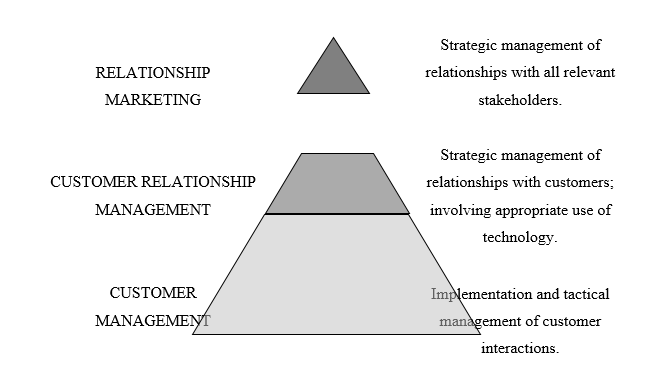
The plethora of the CRM definitions made by various authors confirms the views presented by Hart (2006) and Payne (2006). Although Hobby (1999) and Rigby et al. (2002) define CRM differently, they all include in their definition a common goal, that of profitability. Rigby et al. (2002) define CRM “as the bundling of customer strategy and processes, supported by the relevant software, for the purpose of improving customer loyalty and eventually corporate profitability”. Hobby (1999) defines CRM as “a management approach that enables organizations to identify, attract and increase retention of profitable customers by managing relationships with them”.
Parvatiyar and Sheth (2001) define CRM as “a comprehensive strategy and process of acquiring, retaining and partnering with selective customers to create superior value for the company and the customer”.
The above mentioned definitions of CRM support the central idea and the hypotheses which this dissertation puts forward. CRM has been an asset to the organizations in achieving loyal customers who remain with them for long; thereby, prove themselves to be profitable to the companies.
Many authors have associated and in fact, considered technology as an essential element of CRM and have used words like “strategy” and “process” to refer to automation. Gosney and Boehm (2000) state that for a company to become more customer-centric, it is important for it to utilize web-based tools to ensure its presence on the internet. Zablah et al. (2004) refer to technology as being a CRM. The same perception, that CRM is dependent on technology, is also purported by Khanna (2001) who defines CRM as an e-commerce application.
Peppers et al. (2000) uses the term “personalization engine” to describe CRM as an application of one-to-one marketing and relationship marketing which responds to the needs and wants of each individual customer. Smith (2001) asserts that CRM is a business strategy combined with technology to effectively manage the complete customer life-cycle. Thompson (2001), Lee (2001) and Kramer (2001) also point out that CRM is, both, a business strategy and a supporting application.
It would be wrong to state that CRM itself is technology or cannot function without automation. Technology is used to facilitate relationship building with customers. Online transactions and help desks or interactive voice response devices in different companies assist in making it more convenient for the company representatives and the customers to communicate with each other. This ease of communication and the convenience provided to the customers help build strong relationships with customers. The more value and satisfaction the customers receive, the more loyal they become and the chances of their switching to competitor goods and services decline.
CRM uses technology for ease of communication and efficiency. Glazer (1997) states that CRM “seeks to provide a strategic bridge between information technology and marketing strategies aimed at building long-term relationships and profitability. This requires information-intensives strategies”. Couldwell (1999) uses databases and utilizes technology to improve company profitability by servicing customers well.
CRM, nonetheless, is cross-functional and requires cooperation of every function in the company to be successful. Payne (2006) rightly emphasizes that CRM requires cross-functional integration of people, operations, processes and marketing capabilities that are enabled through information technology applications.
The CRM definitions mentioned above are portrayed as a “CRM-continuum” by Payne and Frow (2005), as shown in Figure-2.2 below. At one extreme (left-hand-side) CRM is defined narrowly and tactically and at the other (right-hand-side) CRM is defined in a broad strategic context.
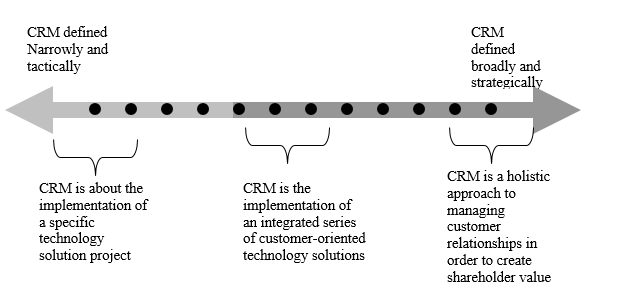
CRM Technology and its Role
Ezingeard et al., (2001) purport that CRM is actually a broad term that has evolved from Marketing Information Systems, Database Marketing, Decision Support Systems, Call Centre Management, and Transaction Support Systems. According to them, CRM encapsulates a wide array of technologies and business processes. However, Payne (2006) gives a more clear view of the relationship between CRM and information technology (IT); he maintains that there is no direct correlation between CRM and IT as CRM is a management approach and IT is a management tool. His theory emphasizes that it is possible to have a highly sophisticated CRM without having highly sophisticated IT. This is exactly the point the researcher wants to clarify in the dissertation.
Internet and e-Business
Russell-Jones (2002) and Foss and Stone (2002) agree that internet technology is fundamental to CRM and e-business. Particularly, Russell-Jones (2002) supports that a CRM programme must take also the internet and its implications into account. Pavich (2003) reveals that, in the past five years, many banks have invested substantial capital in internet and wireless initiatives to improve and enhance customer service.
Foss and Stone (2002) state that the impact of the internet has been profound on the financial services industry. They are of the view that financial institutions wishing to survive and thrive in the second decade of the 21st century must recognize the necessity of e-business and emerging technologies to support CRM. Embedding e-technologies in business operations provide for low-cost operators and readiness to changing customers needs and marketplace conditions. Murphy et al. (2006) state that “the internet is a useful marketplace for the cash rich and time poor” and argues that “the internet information highway lets us shop faster and further afield than ever”.
Types of CRM Applications and Customer Information
Ezingeard et al. (2001) classify CRM applications as three different types. These include the analysis of aggregate customer information like data mining supporting marketing and risk management, service delivery such as sales force automation and content personalization supporting sales, operations and service, and the transformation of service delivery like supply chain integration supporting sales, operations, service and procurement.
Ezingeard et al, (2001) suggest a “tentative taxonomy of CRM applications” as shown in Figure-2.3:
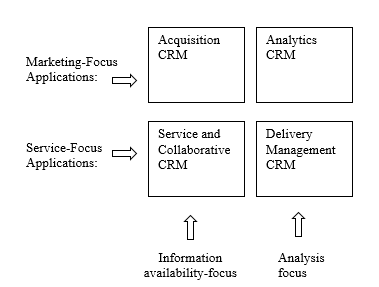
The acquisition CRM applications provide customers with relevant information. Ezingeard et al. view on information has been supported by Szymanski and Henard (2001) who maintain that information is a significant part of any purchasing decision. Customer satisfaction after a purchase is vital. Information improves communication between suppliers and customers. Morgan and Hunt (1994) also purport that communication is a significance predecessor of trust.
The service and collaborative CRM applications greatly improve service delivery, thus transforming the relationship between supplier and customer. A key objective is to support the service and collaboration between businesses, and business and consumers. Bensaou and Venkatranman (1996) state that inter-organizational systems reduce uncertainly in relationships by playing on three determinants of uncertainly: “goal compatibility, trust and power-dependence”. Morgan and Hunt (1994) assert that uncertainly is reduced by showing a higher level of trust in the relationship. The significance of trust is also identified by Rygielski et al., 2002 who state “Trust is so fragile that once violated, it vanishes.”
The analytics CRM applications support the aggregate analysis of customer information. Such applications include Marketing Information Systems (MIS/MKIS) and Marketing Decision Support Systems (MDSS). Key objectives are to improve the quality of analysis by providing quality information to users and by providing for high quality decision making.
The delivery management CRM applications support service delivery. Its objectives are to enhance customer’s experience of service quality. The benefits include service tailoring, service excellence and convenience, reduced variability and reduced service delivery cost.
All the CRM applications provide value and satisfaction to the customers. This helps in gaining loyal, profitable customers who are remain committed to the organization.
Customer Databases – Data Warehouse – Data Marts – Data-Mining
Kotler (1997) defines customer database as an organized collection of comprehensive data about individual customers or prospects that is current, accessible, and actionable for marketing properties. A similar but broader definition, than this, is found in www.answers.com. These help in maintaining data about customer demographics, psychographics, and purchase habits. Various analyses such as trend analysis can be performed on the information to discover unobvious patterns of customer traits and buying habits. Goods and services can be marketed to them accordingly. These are the advantages the dissertation focuses on. Barnes and Howlett (1997) state the same that the use of customer databases has become commonplace in many companies resulting in a close link between CRM and database marketing.
Furthermore, Payne (2006) supports that as business shifts from product-based selling to customer-based marketing after implementing CRM and the supporting systems. He asserts that it is logical and beneficial to have one repository for data, that is, a data warehouse. The need for having one central data warehouse due to the evolving marketing continuum is also emphasized upon by Dwyer and Tanner (2002).
Baker (2003) agrees with the above mentioned authors that a data warehouse contains data from all organizational functions. All the information is worked upon to perform analysis on customer behavior and characteristics.
A data mart is a new concept. Payne (2006) describes data mart as a “single subject” data warehouse implying it is not as grand in scope. A similar definition given by www.learndatamodeling.com. This states that “A data mart is a subset of data warehouse that is designed for a particular line of business, such as sales, marketing, or finance”. This far more useful as customers can be directly targeted for marketing of goods and relationship building.
Antoniou (1997) gives a simple definition of data-mining stating that this “is a process of extracting hidden or previously unknown, comprehensive and actionable information from large databases”.
In Newton’s Telecom dictionary, data-mining is defined as a sophisticated data search capability that uses statistical algorithms to discover patterns and correlations in data. Edelstein (1997) agrees with Newton on the “discovering capability” of data-mining pointing out that data-mining discovers patterns and relationships hidden in your data. He states that data-mining is part of a larger process called knowledge discovery, in which advanced statistical analysis and modeling techniques are applied to the data to find useful patterns and relationships. Gonzale’s (2005) agrees with the above definitions but he explicitly emphasizes that the analysis of the data yields to better decision making explaining that data-mining uncovers new contexts and insights into customer behavior so decision makers can take action based on real knowledge rather than gut feelings.
Gathering Customer Information and Customer Interface
Schmitt (2003) and Kramer (2001) signify the importance of a consistent format for structuring and collecting information. The former suggests that is important to structure the customer interface through which the dynamic exchange of information between a company and its customers takes place. The latter points out that customer information should be entered in the same way, regardless of the channel or department. Bean (2006) reveals that structured data represents 15% of the information that companies store, whilst 85% is unstructured. Furthermore, Foss and Stone (2002) emphasize that a critical element, ensuring the quality of information produced, is for companies to have in place data quality review procedures ensuring that data held is up to date and relevant.
According to McDaid (Figure-2.4)., CRM is implemented based on this model that shows the different channels through which customers can interact with companies, exchanging information, and the various integrated business operations, databases, CRM applications and tools that can be used to analyze information in formulating CRM business strategies.
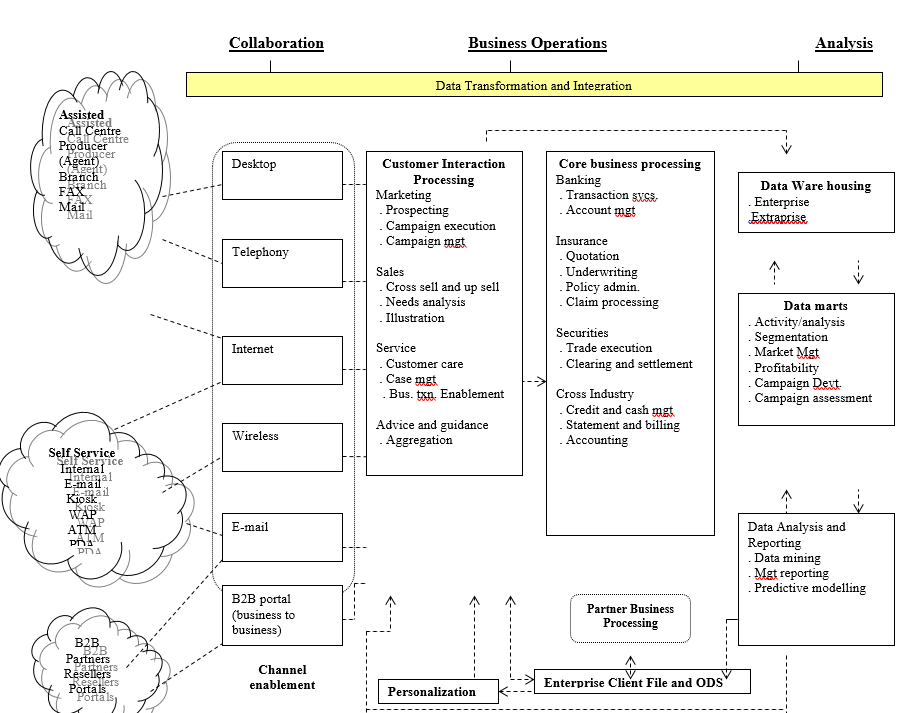
Customer Data Protection and Privacy
Newell (1997) emphasizes that how marketers behave to the privacy issue in the new century would be the key factor in strengthenig customer satisfaction. Similarly, the significance of the privacy issue for customers is also reinforced by Russel-Jones (2002) who regards “trust and privacy” as a customer retention driver.
Laudon and Laudon (1998) define privacy as “the right of individuals and organizations to be left alone and to be secure in their personal papers”. Berendt et al. (2005) agree with Laudon and Laudon (1998) and maintain that it becomes all the more important in the virtual world where electronic transactions take place.
Customers become loyal when they trust the organization. This trust is built when the customers are assured of the privacy of their personal information, and are marketed products and services according to their needs and wants.
Enterprises’ Benefits from implementing CRM Applications
As cited by Eisenfeld (2003), a research was undertaken by a Gartner Research CRM team where enterprises were asked about each of the 14 different CRM applications. The objective was to learn whether they had achieved or expected to achieve benefits in lowering costs, improving efficiency, improving effectiveness and gaining competitive advantage. The results revealed that enterprises which had implemented the correct CRM applications reaped the benefits. These are shown in Table-2.1, below.
Similarly, Chen J. I. and Popovich K. (2003) purport that companies implementing CRM successfully would avail customer loyalty and long run profitability. However, successful implementation is elusive to many companies as they do not understand that CRM requires company-wide, cross-functional, customer-focused business process re-engineering.
Business Strategy and CRM Strategy
Dyche (2002) points out that successful CRM initiatives start with a vision communicated to every facet of operations. Thompson (2002) states that CRM requires a customer-centric business philosophy and culture to support effective marketing, sales, and service processes.
IDM (2002) purported that CRM requires all elements of the business to be coordinated towards customer centricityiii; thus marketing, sales, services, IT, production, distribution, senior management and finance need to be integrated within a coherent set of processes that are designed to optimize customer relationships. Kirkby and Eisenfeld (2001) point out that for a CRM strategy to succeed, changes are required in personnel structures, company culture, customer and internal processes, reward and recognition systems, skills and competencies, information management, measurement systems as well as technology.
A comprehensive model of current and future CRM strategies is clearly given by Payne (2006) (Figure-2.5). The vertical axis shows volume and extent of customer information analysis and the horizontal axis shows the degree the organization uses whatever customers’ information to give them individualized or customized service.
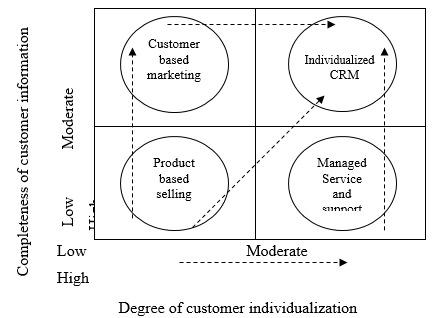
Product based selling strategy focuses on information about transactions doing simple analysis such of product sales over time and channel productivity. There is little information on individual customers. In managed service and support, the business seeks to identify which specific customers it wishes to retain and to place greater emphasis on its most important customers. Customer based marketing seeks to develop a more detailed understanding of its customers. Individualised CRM strategy offers a complete customised service and opportunities for building one-to-one marketing systems through a wide range of channel options.
Customer Loyalty
Seybold (2001) asserts that the hardest thing for a company to acquire is not investment capital or employees. It is customer loyalty. The customers are only a mouse-click away from the competition. The significance of customer loyalty is emphasized by Gremler D. and Brown S. (1996) who state in their study that academics and practitioners agree that loyalty is an integral part of doing business.
Reilly (1996) maintains that “Dissatisfied customers are bad for business. Satisfied customers come back and bring their friends”. Jones and Sasser (1995) concluded through their Xerox research that, customer loyalty depends on the degree of customer satisfaction.
On the contrary, the results of a research carried out by Andreassen W. T. and Lindestad B. (1998) concluded that corporate image impacts customer loyalty directly whereas customer satisfaction does not. This challenges the disconfirmation paradigm which predicts customer satisfaction as the primary route to customer loyalty. However, the focus of the dissertation is on the customer satisfaction which helps in gaining loyal customers.
Murphy et al. (2006) suggests that customer relationships go through different stages called “the customer ladder of loyalty” (Figure-2.6).
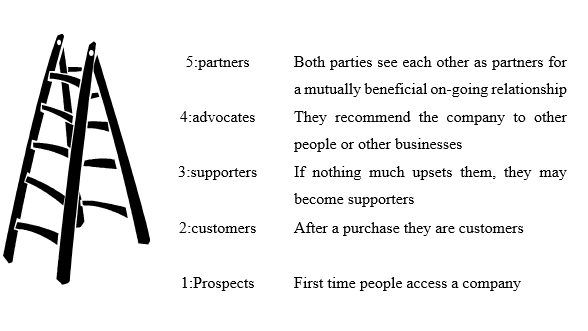
Customer Value Proposition (CVP)
Russell-Jones (2002) states that the term CVP was invented in the 1980’s by Michael Lanning and Dr Lynn Philips, two AAAAAAAA academics. He explains that the term means a customer chooses a product or service between competitors because in the customer’s perception this product or service offers the greatest positive combination of end-results benefits and price. The author defines the CVP as a mathematical equation. Benefit is what the customer gains. Price is the total cost to the customer.
- Value=Benefit-Price
Nycamp (2001) regards CRM as a means to provide value to customers. CRM focuses on providing optimal value to customers, through communicating with them, marketing them the desired products and services, offering them good service. Foss and Stone (2002) state that the products and services offered must add up to truly compelling value proposition for the target audience.
Customer Value and Customer Profitability Potential
Christopher (1997) asserts that most companies focus on identifying the profitability of products rather than customers. However, it is customers who generate profits and not products. Customers create profits and products create costs but. The need of companies to focus on profitable individual customers is stressed out by Payne (2006).
Using Pareto law, Cram (2001) points out that in a world where 80% of business profits come from 20% of business customers, companies can not afford to treat all customers as equal He emphasises that companies need to identify and build relationships with their most profitable customers. The necessity for investing on profitable customers is also pointed out by Zeithaml et al. (2001). Peppers et al. (2000) categorise customers by their value into most valuable customers, most growable customers and below zero customers.
Novo (2001) suggests three factors based on which customers may be selected. These include how recently the customers purchased goods, how frequently they purchase them and how much have they spent on purchases.
Employee Loyalty and Employee Value
Reichheld (1996) states that “If you wonder what getting and keeping the right employees has to do with getting and keeping the right customers, the answer is everything. Employees who are not loyal are unlikely to build an inventory of customers who are”. Pointing out the importance on business of keeping employees happy and loyal, he presents a model (Figure-2.7) derived by Bain & Company. This model shows seven economic effects associated with employee loyalty yielding to the creation of value for both customers and employees.
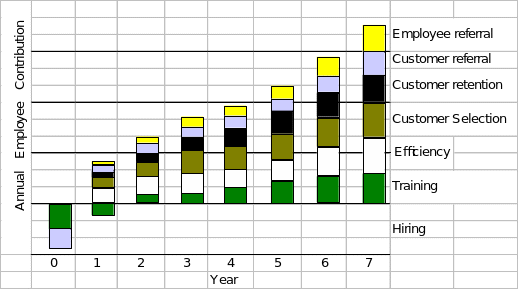
Payne (2006) points out that “a motivated employee can add value to the customer”. Explaining the economic effect of customer referral on business, Reichheld (1996) purports that long-term, loyal employees often generate the best flow of high-calibre job applicants and that loyal employees are sometimes a major source of customer referrals.
Providing the right information and tools to employees also yields motivation. As it is stated in the white paper, Pivotal CRM and the Information Worker, “…with the right CRM solution, information workers can increase productivity, improve customer service, and boost collaboration.”.
Customer Segmentation
Krasadakis (2005) states that “Customer Segmentation is the process of splitting a customer database into distinct, meaningful, homogeneous groups based on a specific methodology”. He supports that the main objective of customer segmentation is to understand the customer base, and achieve sufficient “customer insight” that will enable the “right treatment” on the “right customer” at the “right time” through the “right channel”.
The above definition is congruent with Marcus (2001) citation who suggests that customer segmentation “serves to focus attention on specific sets of customers to understand and address their needs, opportunities or threats”.
Segmentation Types and Segment Strategies
Referring to “traditional-segmentation”, Russell-Jones (2002) states that traditionally the market is segmented based on age, income, geography and type of business. He states that it is often difficult to find a relationship between these segmentation parameters and the customers’ purchase decision and usage. Alternatively, he points out that with “needs-based segmentation”, because the customers’ purchase decision is closely linked to the individuals’ needs and preferences, customers with similar needs are grouped forming a segment which can be analysed in order to be processed within the CRM focusing continuum.
Russell-Jones (2002) suggests the following (Figure-2.8) generic segmentation strategies, which are based on the “segment attractiveness” and the “CVP strength”, and can be adopted by businesses after they have completed their segmentation analysis and understood the strength of CVP in that segment.
A similar to Russell-Jones (2002) customers’ segment strategies matrix but strictly focused on the analysis of customers’ profitability is given by Gordon (1998) in Figure-2.9 below.
Although the two authors base their matrices on different axes the suggested strategies are similar.
Customer acquisition and retention
Rygielski et al. (2002) suggest that given the high cost of acquiring new customers, it makes more sense to conduct business with existing customers. In so doing, the marketing focus shifts away from the breadth of customer base to the depth of each customer’s needs.
Reichheld et al. (1990), through their research, found out that even a 5% increase in customer retention produced as 95% on the net present value delivered by customers
An opposite view is expressed by Christopher et al. (2002) who indicate that a number of studies show that many companies are still more strongly focused on the acquisition of new customers than on developing their existing customer base. This is also confirmed by a study made by KPMG (1997) for different industries as shown in Figure-2.10:
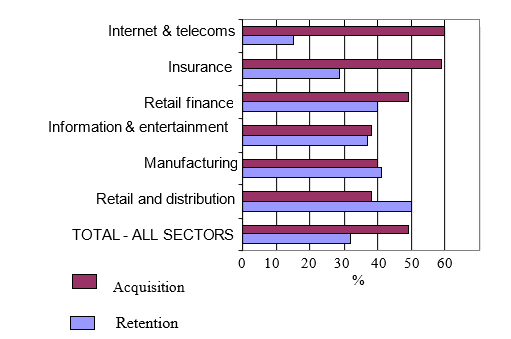
Kotler (2005) gives a balancing suggestion between working on customer acquisition versus customer retention. He suggests that before a company starts worrying about acquiring new customers, it must develop a strategy to satisfy its existing customers.
Furthermore, Russell-Jones (2002) suggests that acquisition and retention of customers are influenced by different drivers, as shown in Figure-2.11:
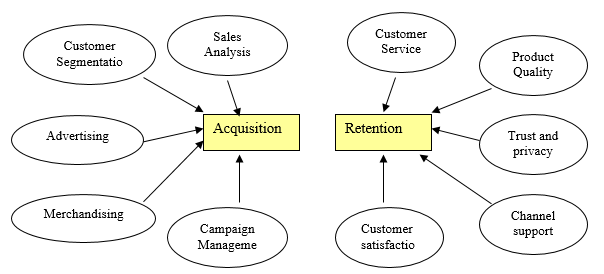
Supplementing the authors above, Griffin and Lowenstein (2001) point out that companies also need to win back their lost customers. Putting together “acquisition management”, “retention management” and “win-back management” strategies they suggest “The Big Three CRM strategies” where they compare them in respect of “Targets and their Product Experience”, “Customer Segmentation”, and “Customer Communication”.
Profit and Cost Reduction
Cost reduction allows for higher profit. Heskett et al. (1997) suggest a “service profit chain” (Figure-2.12). Payne (2006) adds that this chain provides a key logic to the broader perspective of CRM.

The chain suggests that an improvement in leadership and management behaviour leads to employee satisfaction, retention and loyalty which in turn yields to customer satisfaction and loyalty and finally to increase business financial performance and shareholder value.
A different and a more focused approach towards cost reduction and profit increase yielding to increase of financial performance is given by Murphy et al. (2006). They suggest a 5-lever framework which includes reducing cost of acquiring new customers, effective cross-selling and up-selling, increasing lifetime of customer relationships, examining customer servicing costs and targeting profitable customers.
Framework or model presented y Peppers et al. (2000) seem to be a simple process through which profit can be generated. They point out that a dialogue with customers results to profit. Communication with customers helps in gathering information about the. This results in acquisition of knowledge. In turn, this knowledge is directly translated to customer loyalty which then yields to increase of profits. This is illustrated in Figure-2.13:
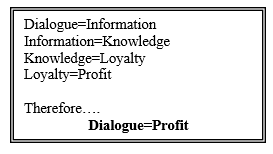
This suggestion is also implied in e-marketing. According to Smith and Chaffey (2001) “speak” with customers constitutes one of the five (sell, serve, save cost, sizzle-extending brand on-line) broad benefits of e-marketing.
The role of Intermediaries
Many authors question the future role of intermediaries in service industries. The advancement of electronic data interchange (EDI) and internet technology provides for inexpensive access to information, direct communication and transactions between customer and seller (Sarkar et al., 1996). As a result, traditional intermediaries are becoming redundant. Malone et al. (1987) suggest that electronic integration creates a cost advantage that implies the disappearance of intermediaries.
Furthermore, electronic markets create opportunities for “reintermediation” of electronic intermediaries. These may be also called ‘cybermediaries’ in that a network-based intermediary offers a range of functions such as product search or product distribution over the internet (Sarkar et al., 1996).
Business Key Performance Indices (KPIs) and CRM Metrics
Neely (2002) emphasizes that developing measures that really reflect what matters in the operation is crucial. Matching the measures to the organizations business processes and, particularly service operations, to customer touch-points is vital. Murphy et al.(2006) adds that there is no aspect of what an organization does that cannot be measured against quantifiable facts, to produce information based on which subsequent action can be taken towards improving customers service.
Payne (2006) distinguishes CRM-metrics from KPIs pointing out that CRM-metrics involve all those CRM-activities that should be measured while KPIs are the high-level measures that are critical to the success of the business and that should be monitored closely by the Board and top management. A similar distinction is perceived by Murphy et al. (2006) who refer to key performance outcomes as the measure of the key results planned by the organisation and to KPIs as the operational measures used in order to monitor, understand, predict and improve the organisation’s likely key performance outcomes.
However, Baker (2003) points out that there is growing concern that metrics generally used by companies for CRM are not nearly as advanced as they should be. He emphasises that more detailed standards, measures and KPIs are needed to make sure CRM activities are managed effectively and that a feedback mechanism exists to increase performance and organisation learning.
In line with Payne, depending on the purpose of CRM metrics and who is using them, Thompson and Nelson (2004) propose four levels of CRM metrics:
- Enterprise: supporting corporate financial and market goals,
- Customer strategy: for monitoring the customer strategy,
- Operational: for monitoring the customer process, and
- Performance: for monitoring efficiency and input.
Similarly, Winer (2001) supports that in a CRM world, increased emphasis is being placed on developing measures that are customer centric giving managers a better idea of how their CRM policies and programs are working. Such measures suggested by Lehman and Winer (2001) are:
- customer acquisition costs,
- conversion rates (from lookers to buyers),
- retention/Churn rates,
- same customer sales rate,
- loyalty measures,
- customer share of wallet.
Balanced Scorecard and CRM – Benchmarking
Kaplan and Norton (1996) developed the Balanced Scorecard tool as a means of establishing non financial measures and a management tool for turning corporate strategy in to specific targets and plans. According to Wood (2004), “CRM and the customer dimension of a balanced scorecard are obviously linked, but it is also clear that the other dimensions affect, and are affected by, CRM strategies, metrics and information”.
Another business performance measurement approach is benchmarking. Wild (1998) supports that benchmarking techniques enable organizations to compare performance to relevant and achievable standards and thus helps secure continual improvement. Daft (2000) emphasizes that benchmarking is a major total quality management component.
Perils of CRM Strategies
Foss and Stone (2001) found that many companies are very disorganized in their approach to CRM , with responsibility being diffused among many competing groups. Tactical rather than integrated solutions are common. Large companies often fail to understand the requirements of scalable, multi-channel strategies, so start with an approach that works in one channel and collapses in another.
A study by Rigby et al. (2002), namely “Avoid the four perils of CRM” identifies four perils of CRM which should be considered before implementing the CRM initiative:
- Implementing CRM before creating a customer strategy.
- Rolling out CRM before changing your organization to match.
- Assuming that more CRM technology is better.
- Stalking, not wooing, customers.
Within the above context, but during the implementing of a CRM initiative, Thompson and Nelson (2004) point out a number of causes of CRM failures, that companies need to avoid when implementing their CRM strategies. In summary these are:
- Lack/Poor Management Commitment.
- Lack of right culture/structure.
- Ignorance of customer needs.
- Failing to consider integration (technology/processes) and architectural issues but the CRM software Package.
- Poor data quality.
- Poor communication within organisation or project.
- Lack of users’ participation in the project.
- No measuring or monitoring or lack/poor testing.
Formulating the Theoretical Framework
This literature reviewed a wide range of CRM salient elements. An adequate foundation and understanding of the CRM and its main principles is achieved. Based on these elements, service companies can exploit a CRM programme towards meeting their business objectives. The researcher formulated a theoretical framework guiding the exploratory nature of this dissertation based on the literature review. The identified issues are grouped together (Figure-2.14) under two categories. One category includes those issues related to the internal perception and capabilities service companies need to have towards the implementation of a CRM strategy for meeting their business objectives and the other includes those needs customers expect to fulfill by the service they get from service companies.
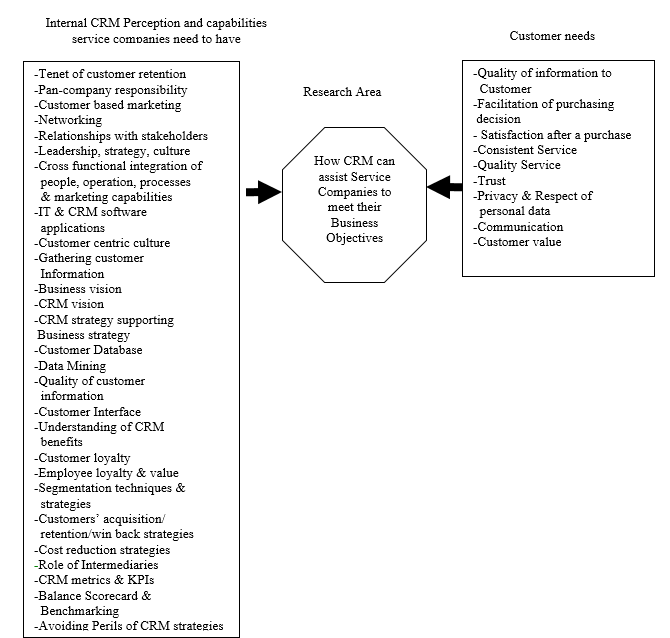
Research Method And Fieldwork
Introduction
This research is contacted based on the CRM elements considered throughout this literature review that has been concluded to the Theoretical Framework presented in Figure 2.14 in Section 2. The research process is twofold reflecting the two research questions, correspondingly. Thus, on one hand it investigates what organizational internal fundamental factors a service company has to acquire before implementing a CRM Strategy and on the other hand it assess whether customers’ needs can be satisfied by the service company that is implementing a CRM strategy.
Research Method
This dissertation follows the survey quantitative research method that it is contacted through a quantitative approach collecting primary numerical data through an appropriate questionnaire and telephone interviews with closed-questions. Kotler (2000) states that “Primary data are data gathered for a specific purpose or a specific research project”.
According to Sekaran (2003) a questionnaire is defined as “A pre-formulated written set of questions to which the respondent records the answers, usually within rather closely delineated alternatives”.
Furthermore, Saunders et al (2003) classifies quantitative data into two groups:
- Categorical, whose values cannot be measured numerically, but arranged according to their characteristics, which can then be further sub divided into descriptive and ranked data.
- Quantifiable data which is usually measured as quantities (numbers).
The data gathered by this research methodology falls into the second group. The questionnaire was addressed to XYZWcross-functional managers (Level 1-3 as shown in Appendix-1.1, page-1), and the telephone interviews were contacted with a sample of XYZWcustomers, respectively.
The questions included in the above data collection techniques were based on the theoretical framework concluded from the literature review of the subject matter.
The questionnaire and the interview schedule was designed in a rating scale form based on Likert’s (1932) scale. Respondents were asked to mark their attitude on a scale rate from 1 to 5 to each one of the closed questions set. Likert’s (1932) scale is chosen since it promotes “standardization of both the asking of questions and the recording of answers” (Bryman, 2001).
Based on the data gathered the hypothesis set is either supported or rejected and appropriate conclusions and recommendations are made.
From its initial stage (data collection) throughout its final stages (analysis of findings and reporting) the research methodology shows absolute respect to and comply with all related ethical and legal issues (including the E.U directive 95/46/EC) regarding the protection of:
- XYZW’s data, and
- individuals’ personal data including XYZW’s customers.
Data Collection Methods – Questionnaire Addressed to XYZWManagers
The objective of this questionnaire was to gather appropriate primary data in order to analyze and identify those organizational internal fundamental factors a service company has to acquire before implementing a CRM Strategy.
This self-completion questionnaire (Appendix-3.1) was addressed to 4 Top Managers (including the General Manager) and 7 Mid Managers. Due to the relatively small number of XYZW Managers the research sample used equaled the population, thus a maximum reliability of the internal survey within XYZW was guaranteed.
The author was given the opportunity by the General Manager to address XYZWManagement team during one of their management meetings at which he:
- Introduced the purpose of this research.
- Informed the meeting about the advantages gained by other service organizations implementing CRM.
- Explained how participants would be asked to be involved into this research.
During this meeting individual appointments were scheduled and later contacted with each one of the managers, where the questionnaire was given to each one of them to complete. The presence of the researcher was there to answer any questions/queries that the managers may had had regarding the questionnaire. Some of the managers requested from the researcher to further explain some of the questions for them where in other cases the managers completed the questionnaire with out queries.
The approach that was described above was considered to be more appropriate to just sending the questionnaire for them to complete alone for two reasons:
- It ensures that each manager would have completed the questionnaire thus achieving the desired response rate of 100%.
- The respondents had the chance to clarify with the researcher the understanding of each of the questions thus capturing their true and fair views.
The questionnaire focused attention on:
- company’s customer focused strategy,
- the process creating value to customers and organization,
- company’s perception on CRM Technology and its current Technological infrastructure,
- the performance assessment process for creating and increasing stakeholders’ Value, and
- the degree of exploitation of Business and CRM performance measures.
Data Collection Methods – Interview Schedule Addressed to XYZWCustomers
The objective of this interview schedule (Appendix-3.2) was to gather appropriate primary data from a sample of XYZWexisting customers regarding their attitude:
- on whether their needs are currently met by XYZW, and
- on how much important if for them to have their needs satisfied.
All questions asked were closed-questions and these were asked to XYZWexisting customers through personal telephone interviews. Each question represented a customer need. For each question the respondent had to declare his/her attitude on whether his/her need is currently satisfied by XYZWand also on how much he/she values the importance of satisfying this need.
Each respondent received exactly the same interview stimulus as any other and their replies were in response to identical cues facilitating reliability and aggregation. The simple random sample technique was used. Thus, the defined population consisted of XYZW 20.000 existing customers in the age range of 30-60. This range was considered to be the most suitable one since people in this age-range are thought of being socially settled and hence more reliable to be in a position to evaluate the degree of satisfaction of their needs and also the importance of having these needs satisfied.
The sample size was decided to be 100 customers (out of the defined population). Every effort was made by the researcher to get a 100% response rate which was finally achieved.
The members of the population were listed with the use of a computer program and each member was assigned a consecutive number from 1 to 20.000. Using another computer program, 100 random numbers from 1-20.000, were generated. Each member of the sample size (100) was assigned such a random number, with a sampling fraction of 1 in 200 (=100/20.000). With this method there has not been any opportunity for human bias to mark this process. Also “randomly selected samples are important since they permit generalisation to the population” (Bryman, 2001).
The time spent to complete each interview was 5 minutes on average. Before the start of an interview the identification of the right interviewee was sought and verified. Sometimes it was necessary to call more than once to “catch” the respondent. In order to save cost, all telephone interviews were contacted by the researcher, thus no interviewers were hired.
The customer needs which were investigated within the context of this survey referred to:
- Quality of information provided to customers.
- Facilitation to Customers’ to make their purchases.
- Customers’ after sales satisfaction.
- Consistency of service given to customers through company’s different service channels.
- Trust the customers receive from their service company.
- Privacy and respect of customers’ personal data by their service Company.
- Value the customers get from their service company.
The questions of this interview ere pre-tested under actual conditions of data collection. As Malhotra (1993) points out pre-testing refers to the testing of the questionnaire on a small sample of respondents to identify and eliminate potential problems.
The pre-testing was contacted with 5 respondents drawn from the same population as for the actual survey. Question content, wording, questions’ sequence, form and layout, questions difficulty, instructions and questions’ acceptance were tested. After the completion of the pre-testing all necessary changes were made in order to rectify the identified problems.
Data Analysis of Findings
The research achieved a 100% response rate from both the surveys. The raw data collected was appropriately analyzed using Microsoft Excel sheets (2003), graphs and tables.
Research Results
This chapter presents the findings of the research and the analysis of the data recorded by the methodology adopted. Although the findings relate to XYZW, the research questions have been structured and developed having in mind their potential validity across the wider service industry. Similarly, the analysis of the findings is performed in a generalized perception taking into consideration their wider applicability in service companies.
Although the sample selected for the research was small, it was ensured by the researcher that it was representative of all the companies in the service sector. The questions asked were not specific to the company. Rather, the questions were so designed that they focused on CRM strategies and the value and satisfaction which the customers derive from maintaining strong relationship with the company.
The aim of the surveys was to capture the true benefits of implementing and practicing CRM in the competitive business environment of today. There is cutthroat competition being faced by the companies in the local as well as global markets. This dissertation concentrated on the CRM strategies and practices of a service company. Although the findings cannot be generalized to manufacturing concerns, they can be used as literature or for basic understanding of CRM is applied in companies. Therefore, the dissertation provides good background information on CRM practices and procedures in companies.
Management Questionnaire – Findings and Analysis
A detailed questionnaire was presented to 11 managers of an insurance company. The aim behind selecting this sample was that theories in the literature review have revealed that it is the employees who actually act as stakeholders and marketers of the organizations. It is them who create an impression about the corporate image of the company in the minds of the customers. They are the ones building and maintaining strong relationships with the customers. Therefore, as they are the ones practicing CRM, it is essentially vital that they be clear on the corporate mission and goals so that the CRM strategies can be aligned accordingly.
The theories presented and critically analyzed in the literature review also present the view that if the employees are not satisfied with their jobs or are not clear on the mission and vision of the organization, they are less likely to build strong relationship with the customers and acquire profitable consumers.
The managers mostly said that they were satisfied with the job. However, when asked questions regarding their knowledge about and views on the company’s policies and vision particularly with regard to CRM, they expressed lack of complete information. They are still on clear on the company’s goals and objectives especially the vision. They know the short-targets which they are required to meet. However, they seldom align the long-term aims of the organization with the CRM strategy.
The results of the research revealed that although the company claims itself to be practicing CRM, the employees are neither sure of the company’s policies and vision nor do they practice any strategies which would directly be in line with the CRM strategies. No criteria is developed as such which help in identifying profitable customers. Neither are the needs nor the preferences of the customers noted and realized so that they can be served accordingly.
Besides in many questions, the responses received from the 11 managers were quite different. In certain questions, patterns of similarity were missing. This could be considered to mean that the employees were themselves uncertain about many of the organizational policies.
Another very interesting point which was noted from the answers was that no conscious measures as such were being taken to address the needs and wants of the customers and earn their loyalty. The information gathered from the interviews of the managers revealed that they were aware to some extent that no concrete efforts were being to build and maintain strong relationships with customers. Although the organization claims to be practicing CRM, the findings revealed that relationship building was very superficial. It is not what CRM is like. This is not very helpful in maintaining loyal and profitable customers.
The questionnaire developed for the study was rather detailed. The aim was to capture as much information as possible regarding the implementation and practicing of CRM in the company. Some of the questions were framed for checking internal validity of the answers provided by the managers for other questions. The aim of those questions was to cross check and verify whether the answers which the managers have provided to the questions corresponding with the hypotheses were correct. Those questions were framed just to check internal validity of the answers.
The questions corresponding directly with the hypotheses have been statistically tested and analyzed. The results have been used to arrive at concrete findings regarding the topic of the dissertation.
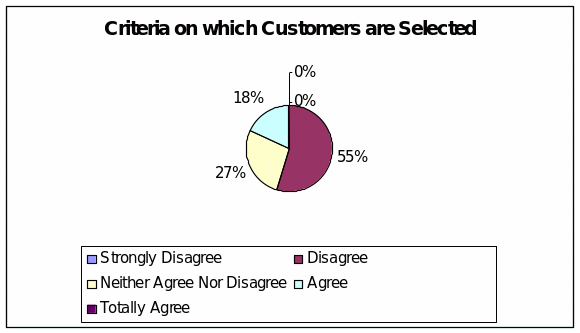
There are no predefined criteria or any policies regarding acquiring profitable customers. This proves that the customers are selected based on the opinions of the managers. No concrete benchmarking is done to avail customers. This means that the company might also be wasting its time and resources if after spending on new customers they realize that they are not valuable and cannot be retained for long.
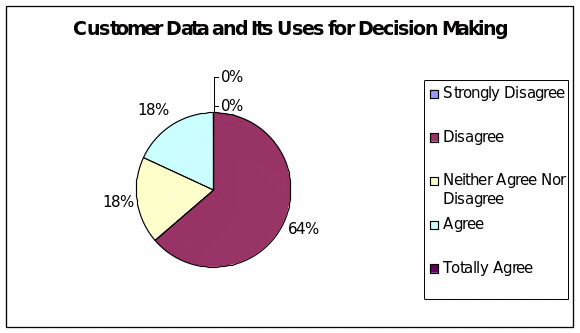
No proper databases or other forms of customer records exist via which their behavioural traits and purchase habits can be analyzed. No trend analysis of any kind is done whatsoever to determine which customers are profitable and should be retained. Many companies use trend analysis to gauge how CRM can be practiced. However, the insurance company under study has no such system in place.
Customers’ Interview – Findings and Analysis
The results of the interviews of the managers reveal that no proper CRM is in place. Neither are any technology tools being used to support CRM in the insurance company. Nonetheless, the responses gathered from the customers of the company depict a completely different scenario. The customers claim to be satisfied with the company and its services.
There is a complication in this as the customers could have possibly been giving answers to please the researcher. Although the customers were assured that their names and identities would be concealed, they were probably not convinced.
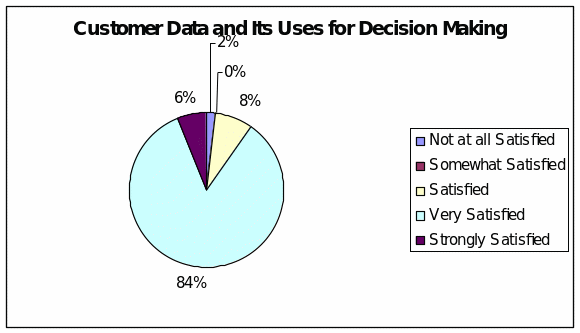
The above illustrated figure shows that 84% of the customers claim themselves to be satisfied with the company. Perhaps, the company has a much trained workforce which builds and maintains relationships with customers without any proper guidelines or pre-defined criteria, and without any technological facility.
Discussion
The findings of the research are reasonably discussed and critically analyzed within the context of the subject’s topic in the literature review. During the discussion the findings are appropriately linked back to the original theories of the literature review. The attempt is to synthesize academic work and literature with the research’s real world pragmatic findings.
The research findings have revealed very interesting points about how the CRM is being practiced at an organization where there are no proper guidelines and rules in place for conducting CRM. There is very little data on customer preferences and habits which can be analyzed by the insurance company. Yet, the company is doing very well in terms of CRM. The customers have expressed their liking for the company’s customer care and support services. The customers are satisfied with the company.
It is rather interesting to note that the company is practicing CRM without any form of automated or technological support. This proves that technology is the end all and be all of CRM. No doubt that technology can be of great help in implementation of CRM.
The insurance company under study does not have a proper database system in place to maintain customer records. Yet, the customers feel satisfied. This means that the company has a well-trained workforce. The employees or the managers are unsure of many company policies themselves; yet, consider the customers to be their top priority.
Recommendations and Conclusion
The chapter presents conclusions from discussion and findings. Also recommendations for future business practice and if necessary, implementation plan. Recommendations could be generalize for any service company.
Recommendations
No doubt the company has been performing well and has been good at building and maintaining relationships with profitable customers. There are still many drawbacks which it needs to overcome in order to succeed in the corporate world. To begin with, the managers must have a clear understanding of the company’s objectives and policies and practice CRM accordingly.
Proper customer records must be maintained in databases and trend analysis must be performed on them in order to get the right picture of how relationships must be built with them. Their traits and purchase behaviour be noted so that products can be offered to them accordingly.
Conclusion
The research study focuses on the benefits which organizations derive by implementing CRM. The dissertation has focused on a service company. The sample chosen for the research is representative of all the companies in the service sector particularly the insurance companies. However, the study provides a good foundation for any research on implementing and practicing CRM in organizations.
The research study is a combination of intensive literature review and quantitative research. Two survey instruments were designed to interview managers as well as the customers and obtain their feedback on how well relationships are maintained and built.
Limitations of the Research/Future Research
Limitations of this Research
Although the initial plan was to extend this research to more than one service company in order to learn about different organizations and their approach to CRM, it did not materialize as most of the companies contacted showed reluctance to provide information. The fear of validity threats arising from the information which the respondents would have provided unwillingly held the researcher back from taking a large sample of participants.
The intention was to investigate other competitors’ view on the elements of the research questions addressed to XYZW Management and compare them in order to conclude and make the best possible recommendations to the research questions. This would have provided a well-rounded picture of the CRM tools and strategies in place in different organizations. The initial aim was to learn how CRM is being implemented and practiced in the increasingly challenging business environment to cope with cutthroat competition.
The inability to research on a large sample has, however, in no way impacted the findings or the results of the research. Although the sample was small, it was very carefully selected. The researcher ensured that no validity threats arise and made efforts to gain as much knowledge through the surveys and literature review. The dissertation is a result of tremendous hard work. In fact, the smaller sample helped to narrow the scope of the report which aided in producing a good quality, well-focused report.
The fact that the sample was smaller has not significantly impacted the quality of the conclusions extracted and the recommendations made. It is commonly accepted that services companies today have similar objectives striving to operate at higher economies of scale and offering competitive service. Thus, accepting the generalization of these objectives for service companies, small or big, it can be supported that the nature of the findings and problems that came to light by examining XYZW only, are related to these objectives and are also applied to any other service company.
The intention of the researcher was also to interview four XYZW agents/rokers (intermediaries) through another additional and different questionnaire. However, the General Manager discouraged this intention by saying that this was not really necessary since the questionnaire addressed to his managers would bring to surface all important and necessary findings. Hence, this research did not check agents’ perceptions on elements related to the subject under investigation.
Another intention was to extend this research to XYZW employees in order to gather their perception on Human Resource and other appropriate issues. This would contribute towards more spherical conclusions and recommendations. Although this was not rejected by XYZW General Manager, it could not be done due to time constraint.
Future Research/Enhancements
The data collected through this research coupled with the recommendations made and the literature review provide ample opportunities for a number of further different challenging studies. The research presented in the dissertation, although much detailed, is not exhaustive. Further research into the topic may reveal some more interesting and valuable insights into CRM approach, tools and strategies. Perhaps, in the later or following researches a larger sample population can be chosen.
The researcher was also constrained for time. Therefore, future studies which would elaborate on this dissertation would know exactly in order to manage limited time efficiently. The topic of the dissertation as well as its content gives plenty of opportunities to interested researchers to build on the dissertation. The researchers basing their research on the dissertation can choose to study the recommendations or elaborate on the literature review.
A very interesting research can be carried out on how the recommendations presented in the dissertation can be applied in real life. The pros and cons and the feasibility of the recommendations can be tested by experimenting implementation of CRM with proper tools and strategies in different organizations, not necessarily only service organizations.
An investigation can also be carried out on how the recommendations made in the report be applied to the company under study. The practical implementation of the recommendations or rather how the implementation of CRM in XYZW (or other service company) can be rolled out is another very important and enlightening research topic.
A very valuable insight into development and launch of CRM in the practical life can be sought if this dissertation is used as a foundation for future research. The study in this dissertation can be of great help to researchers who wish to work on the development and implementation of CRM to any company particularly a service organization.
Another important facet relating to CRM which focuses on employee motivation can be studied. It has been proved by many studies that if the internal customers, employees, are satisfied with the organization, the external customers are automatically provided great value and satisfaction. A research on XYZW employees can be conducted. The views of the employees and how they practice CRM can be studied. A thorough conclusion can be derived along with recommendations related to the CRM exploitation in the company.
Personal Development
This dissertation has definitely resulted to the enhancement of my knowledge of CRM and of my interpersonal skills. It was a great learning experience. The dissertation provided me an opportunity to get a deep in-sight into CRM, its various tools, and strategies for its success and implementation. Now, I realize the true importance of building and maintaining strong relationships with customers. The loyal customers are not only profitable but also act as advocates for the organizations. This helps in gaining new customers and increases the customer bases of companies. Therefore, I have come to acknowledge that CRM has various obvious and unobvious advantages.
The academic knowledge that I have acquired through the related literature review and the articles of the various practitioners is truly enriching. I have learnt to analyze critically the viewpoints of well-known theorists, marketers and philosophers. It also helped me gain a sound knowledge of the topic I was researching on for this dissertation. It prepared me well for the interviews which I had to conduct as part of the research. I knew exactly what questions were required to be asked and how they were to be asked.
The interviews which I conducted improved my interpersonal and communication skills. I learnt how to communicate with people belonging to different companies having varying work environments and attitudes. Almost each respondent had his own style of answering questions. Although the questions in the survey instrument were close-ended and self-administered, each respondent had to be dealt with differently according to his/her disposition and attitude.
This dissertation coupled with the whole OOOOOO’s MBA programme, has furnished me with all the essential and appropriate knowledge, abilities and confidence I need, in order to further undertake similar researches and provide future consultation for service companies adopting CRM strategies. I feel I am well-equipped to meet the challenges of the corporate world now.
I have learnt a lot and have gained a valuable experience by working on this dissertation. Some of the major learning major learning experiences have been elaborated upon. It is hoped that my efforts bear fruit and I get rewarded for the hard work that I have put in. The dissertation has not only helped me developed an understanding of CRM and its importance, it has also led to my personal growth and development.
The dissertation has aided in the development of my interpersonal skills, such as spoken and written communication. I acquired an ability to think conceptually and exercising rational and structural thinking when evaluating similar or differing viewpoints. I was also able to draw patterns of similarity and dissimilarity between the theories and philosophies of different marketers and theorists.
The intensive research study also assisted in the development of research skills and understanding of the practical implications of doing a business research. These included analyzing and evaluating research limitations, documenting and rationalizing the findings, and constructing a report in a structural and logical manner. I made recommendations based on the research findings and the critical literature review.
I have learnt to place myself in the shoes of the others and view the existing strategies followed in the corporate world from their viewpoint. It has helped to appreciate the works and thinking of others. At the same time, it has also aided in broadening my imagining as I have learnt to view the same issue from different perspectives.
The research study enabled development of a cross-checking ability of the various findings of the survey. The evaluation of different alternative approaches to problem solving making practical recommendations for implementation and rectification made me realize my analytical skills.
The discovery of my personal strength to work under vast stress, managing and overcoming serious personal problems with out upsetting the successful delivery of my professional commitments and assignments at the workspace and my MBA Distance Learning studies, respectively. Although I was pressed for time, I worked very hard and was able to conduct a full-fledged intensive research.
I gained a practical understanding of the effectiveness of tasks scheduling, priorities setting and time management issues. I also learnt the necessity of the role of a self discipline as a critical success factor for any initiative undertaken.
The acquisition of knowledge regarding the local ABCDnsurance industry, XYZW business and its organizational insights was truly beneficial. The collaboration with XYZW Management has been a great experience for me. It gave me the opportunity to understand the various organizational cross-functional issues of an insurance service company such as XYZW. This has further increased my potential to undertake future initiatives for insurance companies.
Bibliography
Ampler T., (2002) Marketing p.25.
Andreassen W. T. and Lindestad B., (1998) Customer Loyalty and complex services: The impact of corporate image on quality, customer satisfaction and loyalty for customers with varying degrees of service expertise, International Journal of Service Industry Management. Vol9, Issue:1, Page:7-23, MCB UP Ltd.
Antoniou T., (1997) Drilling or Mining? Handling and Analysis of Data Between Now and Year 2000, Marketing and Research Today, 115-120.
Baker J. M., (2003) The Marketing Book, 5th edition, UK: Butterworth-Heinemann.
Barnes, G. & Howlett D. M., (1997) Predictors of equity in Relationships between Financial Services Providers and Retail Customers. International Journal of Bank Marketing.,Vol. 6. 1-22.
Bean D., (2006) DM Review, Hiding in Plain sight: Where the Data Is, But he Analysis Isn’t, 1(7) pp.3-6.
Bensaou, M. and N. Venkatranman (1996) Inter-organizational relationship and information technology: a conceptual synthesis and a research framework. European Journal of Information Systems 5 (2): pp. 84-91.
Berendt B., G Günther O., Spiekermann S., (2005) Privacy in e-commerce: stated preferences vs. actual behaviour, New YorkNY, USA: V48, Issue 4,pp. 101-106. Web.
Bryman A., (2001) Social Research Methods, Oxford, Oxford University Press, New York, USA.
Chen J I. and Popovich K., (2003) Understanding customer relationship management (CRM): People, process and technology, Business Process Management Journal, Volume: 9 Issue: 5 Page: 672 – 688, MCB UP Ltd.
Christopher M., (1997) Marketing Logistics. Oxford: Butterworth-Heinemann.
Christopher M., Payne, A.F.T. and Ballantyne D. (2002) Relationship Marketing: Creating Stakeholder Value. Oxford: Butterworth-Heinemann, pp 6-57.
Couldwell C., (1999) Loyalty bonuses, Marketing Week.
Cram T., (2001) Customers that count: How to build living relationships with your most valuable customers. UK: Pearson Education Ltd.
Crouch S., (1988) Marketing Research for Managers. Oxford: Heinemann Professional Publishing.
Daft, L.R, (2000), “Management” (5th edition), The Dryden Press.
Davidson H., (2002) The Committed Enterprise, Oxford: Butterworth-Heinemann.
Dwyer R., and TannerJ., (2002) Business Marketing, Connecting Strategy, Relationships, and Learning, second edition, McGraw-Hill Irwin, New York.
Dyche J., (2002) The CRM Handbook: A business guide to CRM. USA: Addison-Wesley.
Edelstein H., (2002) Data mining: exploiting the hidden trends in your data. DB2 Online Magazine. Web.
Eisenfeld L. B., (2003) Management Update: Select CRM Applications Carefully to Get Maximum Benefits, Gartner id number:IGG-03052003-01, p:2-7. Web.
Ezingeard J-N., Nolan R., Money A., (2001) A taxonomy of objectives of IT-enabled Customer Relationship Management as a basis of evaluation of CRM success, UK: OOOOOOManagement Ggggggg, p.17-18.
Foss B. & Stone M., (2002) CRM in Financial Services, UK: IBM Kogan Page Limited.
Foss B. & Stone M., (2001) Successful Customer Relationship Management, UK: Kogan Page.
Glazer R., (1997) Strategy and structure in information-intensive markets: the relationship between marketing and IT. Journal of Market Focused Management, pp. 65-81.
Gonzales L. M., (2005) DB2 Magazine: Insight Beyond The Obvious. Web.
Gosney J., and Boehm T., (2000) Customer Relationship Management Essentials, Roseville, CA: Prima Publishing.
Gordon I.H., (1998) Relationship Marketing. Ontario: John Wiley & Sons Canada Ltd.
Gremler D. D. and Brown W. S. (1996) Service Loyalty: Its Nature, Importance, and Implications, University of Idaho, USA, Arizona State University, USA. New York: ISQA.
Griffin J., Lowenstein M., (2001) Customer Winback: How to recapture lost customers and keep them loyal, California: Jossey-Bass.
Gummesson, E. (1997) Relationship Marketing – The Emperor’s new clothes or a paradigm shift? Marketing and Research Today, p. 53-60.
Hart M.L., (2006) customer relationship management: Are software applications aligned with business objectives?, South African Journal of Business Management , 37(2):17-32.
Heskett L., Sasser, E. Jr and Schlesinger A., (1997) The Service Profit Chain, NewYork: The Free Press.
Hobby, J. (1999) Looking after the one who matters. Accounting Age. p. 28-30.
Hussey, J. and Hussey, R. (1997) Business Research: a practical guide for undergraduate and postgraduate students, PALGRAVE Houndmills, Basingstoke.
IDM (2002) The IDM Guide to CRM Mastery: What is CRM?, The Institute of Direct Marketing, Session-1, p.10.
Insurance Association Of RRRRRR yearly book (2005).
Jones T., and Susser W.E (1995) Why satisfied customers defect. Harvard Business Review, pp.88-99.
Kaplan, R.S. & Norton, D.P. (1996) The Balanced Scorecard: Translating Strategy Into Actio., Boston: Harvard Business School Press.
Khanna S., (2001) Measuring the CRM ROI: show them benefits. Web.
Kirkby J., & Eisenfeld |B., (2001) implementing CRM: Business change program not project. Web.
Kotler P. (1997) Marketing Management: Analysis, Planning, Implementation and Control, 9th edition. New Jersey: Prentice Hall.
Kotler P. (2005) According to Kotler: the world’s foremost authority on marketing answers your questions, 1st edition. USA: AMACOM.
Kotler P., Armstrong G., Saunders J., Wong V. (1999) Principles of Marketing, 2nd edition, New Jersey, USA: Prentice hall Europe.
KPMG (1997) The Hidden Advantage: A Research Report into Data Warehousing, London: KPMG.
Kramer & Associates. 2001. Strategies for successful CRM implementation in Call Centers. Web.
Krasadakis G. (2005), Customer Analytics & Segmentation for telecommunications-Techniques & Applications, dataming Information Technologies. Web.
Laudon C. K. ad Laudon P. J. (1998) Information Systems and the Internet, A problem Solving Approach, 4th edition, USA: The Dryden Press.
Lee D., (2001) Four steps to CRM success, USA: HYM Press. Web.
Lehman D. & Winer R. (2001) Product Management, 3rd Edition, Burr Ridge, IL: McGraw Hill.
Likert R. (1932) A Technique for the Measurement of Attitudes, Archives of Psychology, No 140.
Malhotra N.K., (1993) Marketing Research: An Applied Orientation. USA: Prentice Hall International.
Malone T., Yates J. and Benjamin R. (1987) Electronic markets and electronic hierarchies: Effects of information technology on market structure and corporate strategies, Communications of the ACM, 30 (6), pp 484-97.
Marcus C., (2001) Effective CRM Requires Sound Segmentation. Web.
Morgan, R.M. and Hund S.D. (1994) The Commitment-Trust Theory of Relationship Marketing. Journal of Marketing 58 (3), pp.20-38.
Murphy J.A., Burton J., Gleaves R., Kitshoff J., (2006) Converting Customer Value, from retention to profit, USA: John Wiley & Sons, Ltd.
Naumann E., Jackson D., and Rosenbaum M., (2001) How to implement a customer satisfaction program. Business Horizons, 37-46.
Neely A., (2003) Business Performance Measurement Theory and Practice, Cambridge, UK: University Press.
Newell F., (1997) The New Rules of Marketing, How to Use One-to-One Relationship Marketing to Be the Leader in Your Industry, New York:McGraw-Hill.
Newton’s Telecom Dictionary, Harry Newton, CMP Books. Web.
Novo J., (2001) Drilling Down: Turning Customer Data into Profits with a spreadsheet. USA: Deep South Publishing Company. Web.
Nykamp M., (2001) The Customer differential: The complete guide to implementing CRM. USA: Amacom.
Parvatiyar, A. and Sheth, J. (2001) Conceptual framework of customer relationship management,New Delhi: Tata McGraw-Hill, pp.3-25.
Pavich R., (2003) Using alerting to boost customer loyalty and drive profitability, Card News.
Payne, A., (2006) Handbook of CRM, Achieving Excellence in Customer Management, UK: Butterworth-Heinemann.
Payne A.F.T. (2004) Customer Relationship Management: Choosing the Appropriate Strategy and Technology to Win and Retain Customers, draft working paper, Granfield School of Management.
Payne A.F.T and Frow P., (2005) A strategic framework for customer relationship management, Journal of Marketing.
Peppers D., Rogers M, Ph.D. & Dorf B., (2000) The One to One Field Book: The Complete Toolkit for Implementing a 1 to 1 Marketing Program. New York: Doubleday Dell Publishing Group. Inc.
Pivotal, White paper, Pivotal CRM and the Information Worker. Web.
Radcliffe J., (2001) Eight Building Blocks of CRM: A Framework for Success, Gartner id number:AV-14-9265, P.1-5.
Radcliffe J., (2003) Five Factors Shape Every Enterprise’s CRM strategy,Gartner id number: DF-21-3450.
Reichheld, F.F., (1996) The Loyalty Effect, The Hidden Force Behind, Profits and Lasting Value, Harvard Business School Press, USA: Bain & Company, inc.
Reilly T., (1996) Value-added customer service, The Employee’s Guide For Creating Satisfied Customers, USA Chicago, Illinois: Contemporary books Inc.
Rigby K. Darrel, Reichheld F. Frederick, and Schefter Phil, (2002) Best Practice: Avoid the Four Perils of CRM, Harvard Business Review, Harvard Business School publishing. Web.
Russell-Jones., N., (2002) Customer Relationship Management, A practical approach to effective strategy, UK: Financial World Publishing.
Rygielski C., Cheng J., Yen D., (2002) Data mining techniques for customer relationship management, Technology in Society, Pergamon, 24. p. 483-502.
Sarkar M.B., Butler B., and Steinfield C. (1996) Intermediaries and cybermediaries: a continuing role for mediating players in the electronic marketplace, Journal of Computer-Mediated Communication, 1(3).
Saunders, M., Lewis, P. and Thornhill, A. (2003) Research Methods for Business Students (3rd edition), Pearson Education Limited.
Schmitt H. B., (2003) Customer Experience Management, a revolutionary approach for connecting with your customers, New Jersey: John, Wiley & Sons, Inc.,
Sekaran, U. (2003) Research Methods for Business: A skill Building Approach (4th edition), John Wiley & Sons, Inc.
Seybold P., (2001) The customer revolution: How to thrive when customers are in control. New York:Crown Business.
Smith K., (2001) Getting payback from CRM. Web.
Smith P. R., and Chaffey D., (2001) eMarketing eXcellence: At The Heart of eBusiness, Butterworth-Heinemann, Oxford.
Szymanski, D. M. and Henard D.H. (2001) Customer satisfaction: A meta-analysis of the empirical evidence. Journal of the Academy of Marketing Sience 29(1), p.16-35.
Thomson, B. (2001) The Customer Relationship Management Primer: What You Need to Know to Get Started, What is CRM?section-1, 3rd edition, p.1 Web.
Thompson Ed., Nelson D. S., (2004) How to Develop a CRM Strategy, Id number G00125604, Gartner, Inc. and/or its Affiliates, p:1-28. Web.
Thompson J., (2002) Strategic Management (4th edition), UK: Gray Publishing.
Toffler A. (1990) Power shif USA:Bantam Books.
Wild, R. (1998) Production and Operations Management (5th edition), UK: The Bath Press, Bath.
Winer, R., (2001) A framework for Customer Relationship Management, California Management Review. Vol. 43, No.4.
Wood B., (2004) Use Analytics to Align CPM and CRM Metrics, id number COM-23-0661, Gartner, Inc. and/or its Affiliates, p:1-6. Web.
Zablah, A.R., Bellenger, D.N. & Johnston, W.J. (2004) An evaluation of divergent perspectives on customer relationship management : Towards a common understanding of an emerging phenomenon, Industrial Marketing Management, 33(6):475-489.
Appendices
Appendix-1.1

XYZW Background Information
XYZW(AAAAAAAA ABCDInsurance Company) is among the largest international ABCDinsurance service companies in the world. XYZWoperates in more than 50 countries and it is a member company of AAAAAAAA International Group, Inc (TTT). TTT is the leading XCX based international financial services organizations and the largest underwriter of commercial and industrial insurance in the XCOUNTRY. Its member companies write a wide range of commercial and personal insurance products through a variety of distribution channels in approximately 130 countries, including RRRRRR, and jurisdiction throughout the world.
XYZWTTT has been operating in RRRRRR since 1955 as XYZWTTT ABCDRRRRRR and since 1990 it operates as a part of the Central & Eastern European Region.
Hereafter, the name XYZWrefers to XYZWTTT ABCDRRRRRR, unless otherwise stated.
XYZWemploys 53 people; it has a wide distribution channel consisting of 12 branches and 130 agents all over RRRRRR. Currently, XYZWTTT ABCDRRRRRR customer portfolio has 70.000 customers approximately.
Appendix-3.1
Questionnaire addressed to XYZW Management
Appendix-3.1
XYZW TTT ABCD Cyprus
Internal Questionnaire – Confidential
Appendix-3.2
XYZW TTT ABCD Cyprus
Customer Survey
Purpose & Objective: To assess customers’ needs and investigate whether these can be satisfied by the service companies implementing a CRM strategy
Addressed to: A sample of 100 Customers of XYZW TTT ABCD Cyprus.
Method: Telephone Interview
Scope: With reference to XYZW customers this survey focuses attention on evaluating whether customers’ needs are currently satisfied as well as the degree of the importance customers perceive for these needs:
- Quality of information provided to customers
- Facilitation to Customers’ to make their purchases
- Customers’ after sales satisfaction
- Consistency of service given to customers through company’s different service channels
- Trust the customers receive from their service company
- Privacy and respect of customers’ personal data by their service Company
- Value the customers get from their service company
Please mark your choices for both “Current Level of Satisfaction” and “Importance of this Need to Customer” for each one of the following questions. The columns under “Level of Current Satisfaction” represent the current level the customer is satisfied with the particular need in question and the columns under “Importance of this need to customer” represent the importance the particular need has to the customer.
